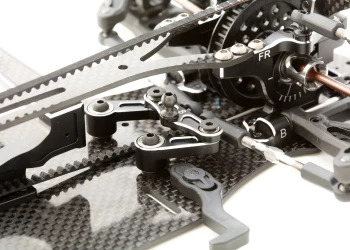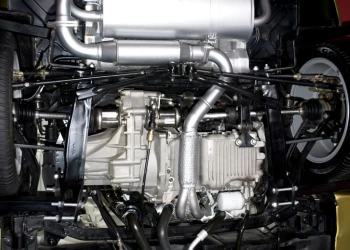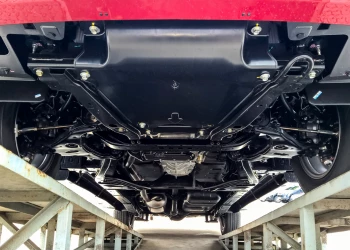Taking faster corners: high-tech steering comes of age
Add bookmarkSteer-by-wire technology is already here. But giving such systems a real-world feel that makes drivers comfortable in their vehicle has been the missing piece of the puzzle. Until now.
“Infiniti’s new steering system is a big step forward - unless you love cars.”
This headline appeared in a Wired Magazine review of the Infiniti Q50 in 2014, shining a dim light on the first production car to be fitted with a steer-by-wire system. Critiquing the then-new Infiniti Q50, the author was less than impressed with the vehicle’s drivability.
An instinctive feel for the vehicle’s behaviour is an important haptic function for drivers. Steering feel is just one of the feedback vibrations created by the moving vehicle, although it is the most important. Accelerator (throttle) feel and centrifugal slide are also important sensations that the driver can key in on when controlling a vehicle. They all contribute to the split-second decisions about steering force and speed.
Steering additions that add feel to the experience are more complicated than they first might seem. Initially, it appeared that a resistance device on the wheel might serve the function; the faster and harder the wheel was turned, the more resistance the module would put on the turning mechanism. However, this turned out to be far too simple.
Carmakers, off-road vehicle manufacturers and heavy vehicle makers of all kinds aim to provide the most realistic steering experience that all drivers count on, especially in emergency and other fast-movement situations. This article examines some of the latest technical and common-sense solutions now in the works.
Algorithms and calculations
Electric vehicles were so quiet at low speeds that they were deemed dangerous at junctions and in other low-speed, crowded areas. Logically, this led to calls from drivers, pedestrians and safety groups for some kind of sound to be emitted by EVs when they are travelling in traffic.
But what sounds like a simple fix hasn’t been easy to implement. Car companies and industry regulators are still debating when and where some kind of sound is necessary, while adding sound also requires hardware and software, which adds weight and expense. What type of sound is also up for debate, with some companies even adding a warning scale of sounds as the vehicle nears junctions.
Similarly, adding steering feel components has not been easy or accepted by everyone. Companies and regulators agree that the technology adds a safety factor to the handling of the vehicle, but they disagree on the best method to achieve the desired result. Mimicking a complex reactive system controlled by a person is difficult. For example, research on robots designed to mimic human movement is complicated by this ‘feel’ question; machines are still some way from having the ability to react in the way our bodies react to touch stimuli.
So, the industry relies mainly on advanced electronics reacting to the physics of the vehicle, wheels, tyres and steering wheel in motion. The algorithms created by observational electronics during real and modelled driving are used to create the most realistic feel parameters by mechanical means. Disturbance feel and reaction torque are figured into the algorithm that determines the amount of the feel effect. The disturbance forces like road surface, tyre grip and slippage are combined and called general disturbance.
The hysteresis effect, in which reaction of the system as a unit is delayed due to residual actions preceding it, is also figured into the algorithm. However, hysteresis can’t be eliminated completely because the system would have to anticipate movement before it happens. This would lead to potentially dangerous assumptions by the software.
A design to combat hysteresis and its impact on the safety of steering-by-wire uses models that decrease response time as the steering becomes more vigorous. “By modifying the mathematical model of the hysteresis model for a steering system and adding custom parameters, the availability of adjusting the shape of steering feel model for various physical and dynamic conditions increases,” the report said.
The state of steering
Companies struggling through the steering system design problems are using steering in slower off-road vehicles as platforms for research. Lord Corporation built a system with a Tactile Feedback Device (TFD) that offers feel provided by magnetic resistance. Tactile devices are designed to mimic the feel of hydraulic systems, the feel all drivers know well. This TFD is positioned between the wheel and the main steering controller, which sends the signal to the drive wheel motors.
The tactile feedback is essential to the driver since it helps prevent over- or understeering. By installing variants of the TFD in equipment driven at low speeds and not on highways, Lord is able to test many driving surfaces and vehicle responses:
“[TFDs] were developed and have been widely used in the last two decades in applications ranging from lift trucks, agricultural equipment, construction equipment, greens mowers and small industrial vehicles,” said the company in a statement.
Lord also said that the feel of the steering mechanism can be changed by software without changing the motorized magnetic unit attached to the steering base.
Here’s an example of changed feel: a forklift truck under full load, and moving at three miles an hour, has a different feel from one that is empty; an empty truck travelling at three miles an hour feels different from an empty truck traveling at six miles an hour, and so on.
Technology for solving this problem has reached very complex algorithmic status. In this report, the construct is offered to relieve disturbance effects in a complex manner: “… a novel active disturbance rejection control (ADRC) strategy is proposed that replaces the Linear Extended state observer (LESO) used in conventional ADRC with a Nested LESO (N-LESO), functionally formed by connecting two LESOs in parallel.” This involved system hopes to reject disturbance in an increasing amount as disturbance interferes with normal feel.
An important distinction must be made between adding feel to the experience and influencing the actual steering of the vehicle. These devices are getting a lot of use in slow, indoor vehicles like fork lifts. Heavy equipment like tractors will provide a lot of data about feel, wheel/tyre disturbance and tactile firmness.
To do this, trials must include human drivers; simply identifying forces by computers over courses built for starting and stopping will not be enough. Theory must become workable models for use in high-speed road vehicles. The most important goal for manufacturers now is to make a system practical, simple and safe.
The future today
One company at the top of its game in high-tech but practical steer-by-wire and drive-by-wire products is Paravan GmbH in Germany. The company unveiled a system that fully drives a 2017 racing vehicle by joystick, servomotors and selector switches. Working to develop a product for all types of vehicles, the company said the patented system has been tested for 20 million kilometres under various stress loads.
The practical development of a lightweight system is the most important step yet. The company claims complete redundancy in the electronic and mechanical segments of the unit. Other features it claims the system includes are perfect individual adaptation, even for advanced changes; dual safety using two systems running in parallel, and full engine power if the control circuit fails; exact computer configuration of parameters; safe speed-controlled steering – even at high speed; ergonomically relaxed driving and superb value for money.
In August 2018, Germany’s Shaeffler Group announced that it will acquire the drive-by-wire Space Drive assets of Paravan.
Nexteer Automotive, based in the US, has been working on ultra-high-tech steering solutions for many years. The company now offers a premium steer-by-wire package with three practical must-haves for car companies: added steering functions, packaging for all vehicles and intelligent, dynamic feel.
Nexteer possibly summed up the driving experience that many people want from current and future cars: “We believe that even though a steer-by-wire system may disconnect the mechanical connection, it shouldn’t disconnect the heart of the driver with the thrill of the road.”
In addition to servomotor drive, the system offers Quiet Wheel, which is claimed to keep the steering wheel still while all other functions of autonomous driving are working. Certainly, high-speed vehicles with no driver are a few years away, but these products being put through all the design and manufacturing paces, and released for use in extensive testing, mean that we will have safe-reliable drive-by-wire systems to look forward to soon.





















